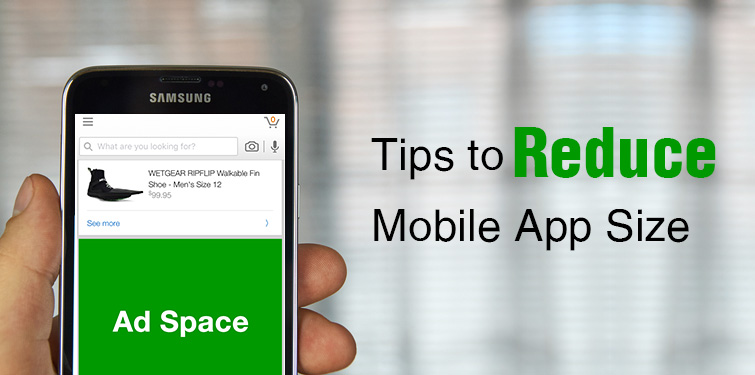When it comes to user retention, the size of modern apps is a major concern for the developers. The spaces on the mobile devices are constricted. So, if you need your app to stay longer on them, trim its size. As a matter of fact, you must know that nearly 50% smartphone users delete the apps that consume a lot of space on their device.
Once downsized, it runs faster on the mobiles. As such, making the apps lighter will soon become a norm for the industry. Even, the app stores are increasing the restrictions on space usage. Apple is contemplating the reduction of app size to 4GB. Hence, you need to ensure that your app isn’t deleted by the users due to its massive size.
Here are the ways to reduce the size of iOS and Android apps:
- Use Apple’s App Thinning Tools:
Apple has introduced the new thinning options that reduce clutter from the apps. It saves the spaces on the smartphones by reducing the unnecessary elements automatically. On uploading an app to the store, it will create multiple versions of the same. These versions are made distinctively for each type of model. Supposedly, if a user of iPhone 7 is looking to download an app, the store will provide the iPhone7 version of the same app. It also has On-Demand resources allowing the downloading of content on the fly.
- Use Android Resource Shrinking Tools:
This is a tool eliminating the unutilized resources like menus and layouts from Android-based apps. It also offers printable diagnostic to comprehend the reasons behind removal or retention of a particular resource. However, this tool does not remove the defined resources existing in the folders.
- Using Media Optimization for iOS:
This process ensures saving a lot of space on your mobile devices. It defines the optimisation of every form of media. For images, you can use 8-bit PNG when it is not essential to create 32-bit images. Use ‘Save for Web and Devices’ feature of Photoshop to save them in an appropriate size. It also recommends compressing the audios to smaller MP3 files and limiting the number of videos. The videos should be compressed to .mp4 size to save extra spaces.
- Image Compressor for Android:
Android uses a tool called Android Asset Packaging Tool or AAPT. It can convert a true color PNG into 8-bit size using its color palette. This image will be much smaller in size but it will be displayed with the same quality. Apart from AAPT, there are other image compression tools like PNG Crush, ImageOptim, PNG Quant, and Image Alpha. For compression of images on the web, you can use WebP image format that compresses images to 26% smaller size as compared to PNG images.
- Static Code Analyzer:
There are some trusted static code analyser that you can integrate into your app. These analysers can easily identify the non-transferable program files, unused functions, bugs, unused automatic variables, etc. These elements are easily removed from the app after creating a detailed HTML report of the same. The static code analysers include Lint for C, SonarQube for Java, and Source Meter for Java, RPG IV, and C/C++.
- Use Java Class File Shrinker for Android:
When developing a small-sized app for Android devices, you can use the tool called ProGuard for optimising the code. It works with a template-based configuration working as a file shrinker. This tool removes the unused codes and compresses the byte-codes for their optimisation. It is enabled by plug-ins and an optional graphic interface.
- Reduce The Architecture in Android:
You can reduce the size of architecture in Android apps by using Android Log Print Method. It helps in limiting the number of Isostreams. Also, consider Armabi and x86 architecture for developing the apps using native libraries and codes.
- Monitor the Memory Allocations in iOS:
You can use Allocations Instrument to monitor the size of memory allocations in iOS-enabled devices. This tool provides data related to total allocations and their frequency. As such, you can delay the memory allocations until they are needed by the app. Consider writing the code in SWIFT language for managing the memory and automatically clearing up the spaces. It manages the memory allocation by using Automatic Reference Counting or ARC method.
- Scanning IPA File in iOS:
You can also speed up the performance of your app by scanning the IPA file installed on the device. This will offer insights into the reasons for increase in the size of .ipa files. Remove the extra files claiming extra space on the devices. Your app will run more rapidly and smoothly.
- Recycle the Code:
For any app, you can optimise its size by recycling its code wherever possible. In Android devices, you can use tint and colour filter modes for re-colouring the codes for recycling purposes. Also, you can use Rotate Draw-able for rotated versions of certain resources. This way, you can prevent the repetition of a code and save a lot of space.
All these techniques help in downsizing the apps making them faster to install on the smartphones. If you implement these, your app will get more downloads and better ratings from the users.
Arun Goyal
Latest posts by Arun Goyal (see all)
- Mobile Inventory Management: A Step Towards Better Future! - July 4, 2022
- Right Measures to Combat the Risks Involved in Mobile App Development - October 9, 2017
- Tips to Reduce Size of Android and iOS Apps - March 7, 2017





